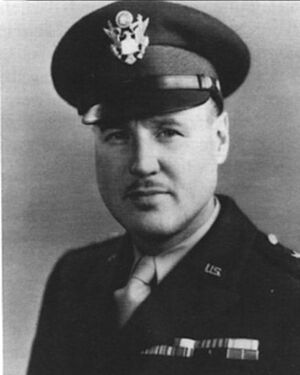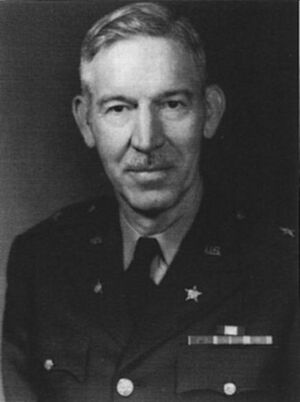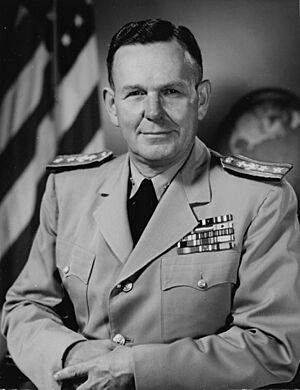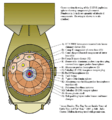Armed Forces Special Weapons Project facts for kids
Quick facts for kids Armed Forces Special Weapons Project |
|
|---|---|
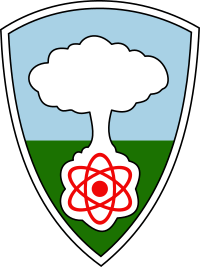
Armed Forces Special Weapons Project patch
|
|
| Active | 1 January 1947 – 6 May 1959 |
| Country | |
| Garrison/HQ | Washington, D.C. |
| Commanders | |
| Notable commanders |
Leslie Groves Kenneth Nichols Herbert Loper Alvin Luedecke |
| Insignia | |
| Seal | 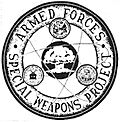 |
The Armed Forces Special Weapons Project (AFSWP) was a special group in the United States military. It was created on January 1, 1947. Its main job was to handle nuclear weapons after World War II.
This group was in charge of many important tasks. They kept nuclear weapons safe and ready to use. They also made sure the weapons were stored correctly. AFSWP also helped with nuclear testing, which means trying out new nuclear weapons.
AFSWP was a joint effort. It had members from the United States Army, United States Navy, and United States Air Force. The first leader of AFSWP was Major General Leslie R. Groves, who had also led the secret Manhattan Project during the war.
In the beginning, nuclear weapons were very big and complicated. They were stored in parts, not as complete bombs. Special experts were needed to put them together. Over time, nuclear weapons became smaller and easier to handle. AFSWP then focused more on managing the large number of weapons. In 1959, AFSWP changed its name to the Defense Atomic Support Agency (DASA).
Contents
How Did AFSWP Start?
Nuclear weapons were developed during World War II. This secret project was called the Manhattan Project. It was led by the United States, with help from the United Kingdom and Canada. Major General Leslie R. Groves Jr. was in charge from 1942 to 1946.
The Manhattan Project built special factories. These factories made materials like enriched uranium and plutonium. Scientists also designed the bombs at Los Alamos, New Mexico. These bombs were used in August 1945. They were dropped on the Japanese cities of Hiroshima and Nagasaki.
After the war, the Manhattan Project helped with nuclear tests. These tests happened at Bikini Atoll in 1946. They were called Operation Crossroads. These early nuclear weapons were handmade. A lot of work was needed to make them safer and easier to use.
General Groves was worried about losing skilled people. Many soldiers and scientists wanted to go back to their normal lives. He feared that no one would know how to handle these special weapons. Groves asked for the best young officers from West Point. He wanted them to join bomb-assembly teams. These teams would work at Sandia Base.
It took time to create a new agency. The Atomic Energy Act of 1946 set up a civilian group. This group was called the United States Atomic Energy Commission (AEC). It took over from the Manhattan Project on January 1, 1947. The Act also created a military committee. This committee would advise the AEC on military matters.
How AFSWP Was Organized
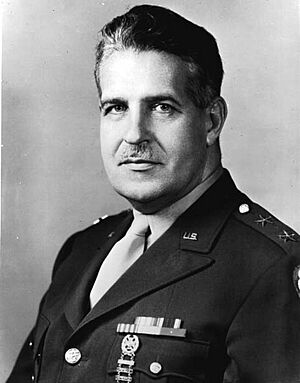
The Secretary of War, Robert Patterson, asked General Groves to create a new military agency. This agency would handle nuclear weapons. It was officially started on January 29, 1947. It would have staff from both the Army and Navy.
General Groves was chosen as the first head of AFSWP. He had a deputy from the Navy. Later, after the National Security Act of 1947 created the Air Force, AFSWP also got a deputy from the Air Force. This made AFSWP a truly joint organization.
AFSWP's main office was first in Washington, D.C. It later moved to the Pentagon. This new office had special secure rooms. These rooms were used to store important records and films.
A special Army unit, the 2761st Engineer Battalion (Special), was formed. This unit was trained to assemble bombs. They created three teams of 36 people each. These teams learned how to put together the complex nuclear weapons.
Soon, the Navy also needed its own special weapons unit. They planned to use nuclear weapons with their new North American AJ Savage bombers. These bombers would fly from aircraft carriers. The Air Force also created its own units. By the end of 1949, the Air Force had many more assembly units than the Army or Navy. This showed that the Air Force was becoming the main user of nuclear weapons.
There was a discussion about whether the Air Force should take over AFSWP. The Air Force believed it should, because it was in charge of strategic bombing. But the Navy strongly disagreed. They feared it would stop them from getting nuclear weapons. In the end, it was decided that AFSWP would remain a joint organization. It would answer to the chiefs of all three services.
Working with Nuclear Weapons
The nuclear weapons available in 1947 were not ready-to-use bombs. They were stored as separate parts. For example, the fissile cores (the nuclear material) were kept apart from the explosives. This was because the cores produced heat. This heat could damage the plastic explosives over time.
The bombs also had special parts that needed regular checks. Their batteries, similar to car batteries, had to be charged often. After a few days, the bomb had to be partly taken apart to recharge them.
The Army's special teams studied all these parts. They learned about the electrical systems and the explosives. A special "nuclear group" went to Los Alamos Laboratory to study the cores. They even attended lectures by famous scientists like Edward Teller and Enrico Fermi.
These teams spent a month figuring out the best way to assemble a "Fat Man" bomb. They wrote detailed checklists. This helped train future bomb assembly teams. It took them two weeks to assemble their first bomb in December 1946.
In November 1947, the Army battalion did its first big practice. It was called Operation Ajax. They took bomb parts (but not the nuclear cores) from the AEC. They flew to Wendover Air Force Base in Utah. This base was home to the only planes that could carry nuclear weapons. The teams practiced assembling bombs and flying training missions. They even dropped a practice bomb.
Other exercises followed. In one, the base personnel practiced defending against an "attack" by paratroopers. In another, a Navy unit practiced assembling bombs on an aircraft carrier.
Supporting Nuclear Tests
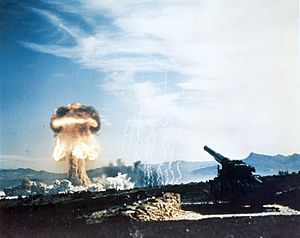
AFSWP also helped with nuclear weapons testing. For Operation Sandstone in 1948, many AFSWP personnel were involved. These tests were very successful. The new Mark 4 nuclear bomb, which came out in 1949, was much easier to assemble. It needed fewer people on the assembly team.
After Operation Sandstone, AFSWP's role in tests changed. They became more involved in planning and coordinating tests. Scientists usually handled the actual bomb assembly during the tests. AFSWP personnel also taught military members about nuclear tests. They showed films and gave lectures to thousands of soldiers. This helped prepare them for what would happen during the tests.
Who Controlled the Weapons?
When the AEC was formed in 1947, it took control of all nuclear weapon parts. But the military wanted to control them. They argued that in an emergency, the military needed quick access to the weapons. They also felt that the soldiers who would use the weapons needed practice with them.
The head of the AEC, David Lilienthal, believed that civilian control of nuclear weapons was very important. He was worried when AFSWP conducted Operation Ajax without telling the AEC first.
General Groves retired in 1948. Kenneth D. Nichols took over as the new head of AFSWP. President Harry S. Truman told both the AEC and AFSWP to work together.
However, Truman decided that the AEC would keep control of all nuclear weapons. He believed that civilian authorities should manage all parts of the nuclear program.
When the Korean War started in 1950, things changed. It became harder to transport bomb parts quickly. So, it was decided to store non-nuclear parts in Europe and the Pacific. This way, only the nuclear parts would need to be flown in an emergency.
President Truman also allowed some nuclear weapons to be given to the Air Force. These were flown to Guam. By the end of 1951, the Department of Defense held nine nuclear weapons. The AEC still held many more.
In 1953, President Dwight D. Eisenhower agreed to deploy nuclear parts alongside non-nuclear parts. The Atomic Energy Act of 1954 changed the law. It no longer gave exclusive control to the AEC. By 1959, the military held most of the nuclear weapons.
As nuclear weapons became smaller and simpler, AFSWP's role changed. They focused less on training assembly teams. Instead, they managed the growing number of nuclear weapons. They also gave technical advice and logistical support. In 1953, AFSWP had over 10,000 people. They were also put in charge of tracking all nuclear weapons. A special center was created to know the status and location of every weapon at all times.
Becoming the Defense Atomic Support Agency
In 1958, President Eisenhower wanted to improve the Department of Defense. He was concerned about different military branches doing the same work. He also worried about the high costs.
The Defense Reorganization Act of 1958 was signed into law. This law gave more power to the Secretary of Defense. It allowed the creation of new defense agencies. The first new agency was the Defense Atomic Support Agency (DASA).
DASA took over AFSWP's responsibilities. It was in charge of overseeing all military nuclear sites. Its role and organization stayed mostly the same. Rear Admiral Edward N. Parker, who was the last commander of AFSWP, became DASA's first director. Later, as nuclear testing stopped and Cold War tensions eased, DASA's mission changed.
Images for kids
See also
 In Spanish: Proyecto de Armas Especiales para las Fuerzas Armadas para niños
In Spanish: Proyecto de Armas Especiales para las Fuerzas Armadas para niños


